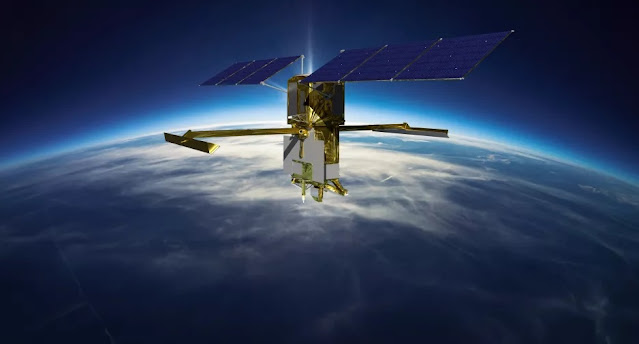In a blog post last Thursday, the team checking out the joint NASA and French space agency CNES mission called SWOT, or the Surface Water and Ocean Topography satellite, ran into a serious problem with perhaps the most important instrument on the satellite.
The Surface Water and Ocean Topography (SWOT) satellite's main science instrument, called KARIN (Ka-band Radar Interferometer), "unexpectedly shut down" due to a problem with the high-power amplifier subsystem...
...KARIN includes twin antennas working roughly 33 feet (10 meters) apart, or half the length of a tennis court. When functional, one of the antennas generates a radar pulse that reflects off the Earth, then both antennas pick up the signal.
"Once the KARIN instrument is up and running again, the mission will continue with its commissioning and calibration activities—planned March through June—to ensure data accuracy in preparation for the beginning of science operations in July 2023," NASA officials wrote.
This strikes a nerve with me as I may not have been a Master power amplifier designer (there are no ranks like that), but I have designed a few and spent pretty much my entire working life around PA designs and designers. Almost without exception, the most expensive piece of radio hardware on a satellite radar is the transmitter. On more than one satellite I've seen, there wasn't a redundant backup which means if the PA fails the mission is over. It was deemed so expensive they couldn't afford a backup and would say "buh-bye" to the mission.
The SWOT satellite. Knowing almost nothing about the satellite design, I would think those two gold-colored bars on gold-colored beams sticking out of the body of the satellite are the two radar antennas. Image by CNES. (I also know they have the solar panels pointed in a useless direction, but I'll give them the "they know not what they do" pass.)
Assuming this isn't a fatal error and they can find a way to restore operation to the power amplifier system, SWOT is supposed to examine 1.3 million miles (2.1 million km) of rivers, along with coastlines and millions of lakes. Calibration and checkout is supposed to be March through June so operations haven't been slowed or stopped at this point.
You may recall that SpaceX launched the SWOT satellite from SLC-4E at Vandenberg Space Force Base, California last Dec. 16. Measuring water levels is key to determining if there are effects from "global warming" and how big those effects might be.

One would think they have a redundancy built in to the electronics, no?
ReplyDeleteProbably, but not necessarily. They don't give any data on the exact frequency they're using and power levels, but Ka band covers 26.5 to 40 GHz. If it's hundreds of watts at 40 GHz, that's more expensive than at 26.5. A quick web search shows solid state Ka band amplifiers in the 300 W range at 36 GHz. Ordinarily, it would be redundant with two amplifiers and switching.
DeleteMy guess here is that the software probably did something unexpected, but again, not enough information to know. They apparently don't know.
"To err is human, but to really screw things up requires software."
A conspiracy minded person might think there is more to it than a random error, if "Measuring water levels is key to determining if there are effects from "global warming" and how big those effects might be. "
ReplyDeleteNot that I actually think that, I've got no data either way, and wasn't paying any attention to the satellite or its mission.
Seems nuts though to have a mission with a point source failure like that.
n
This document (https://swot.jpl.nasa.gov/system/documents/files/2178_2178_SWOT_D-79084_v10Y_FINAL_REVA__06082017.pdf) contains a table of basic parameters for the Ka band radar interferometer (Table 3). The peak transmit power is listed as 1500W, which is pretty sporty for a Ka band system. The final power amplifier is most likely a TWT.
ReplyDeleteDidn't mean to enter that anonymously.
DeleteWell, satellites and TWT's are an older, proven hardware combo, so if it IS the final output then the failure is most likely elsewhere, hardware or software. But we don't have any info either way. Isn't speculation fun??
DeleteThanks for that update, John! Interesting reading. I left the mil/aerospace world in 1996 and the last satellite I worked on was closer to '92. That was a TWT, only it was 14 GHz. It was a scatterometer for measuring wind speed from orbit.
Delete"First rule of government spending: why build one when you can have two for twice the price. "
ReplyDeleteThanks for the explanation SiG. I saw "SWOT" and thought "Strengths, Weaknesses, Opportunities, and Threats? They have a satellite for that?"
ReplyDeleteFOCUS, TB, focus! :)
Delete